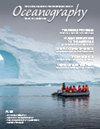卫星遥感和海洋生物多样性观测网:当前的科学和未来的步骤
IF 2.8
4区 地球科学
Q1 OCEANOGRAPHY
引用次数: 6
摘要
由于人类造成的全球变暖、海平面上升、环流模式变化、海冰流失和酸化,沿海生态系统正在迅速变化,而这些反过来又改变了海洋生物群落的生产力和组成。此外,与人口和经济增长相关的区域压力导致基础设施、土地利用和其他发展的变化;更多地开采渔业和其他自然资源;海底海景的改变;污染加剧;以及富营养化。了解生物多样性对于评估和管理维持生态系统健康和服务以及减轻人类轻率行为的人类活动至关重要。遥感观测为评估多个空间和时间尺度上的生物物理相互作用提供了快速的天气数据,因此有助于监测关键沿海地区的生物多样性。然而,由于复杂的生物光学信号、较差的信号检索和次优算法,仍然存在许多挑战。在这里,我们重点介绍了四种遥感方法,它们是对海洋生物多样性观测网络的补充。MBON观测有助于量化浮游生物的功能类型、基础物种和独特的物种-栖息地关系,并为物种分布模型提供信息。这些努力与多个平台的现场观测相结合,通过提供海洋学背景,促进算法和指标的开发,并在长期生态研究、下一代卫星传感器和海洋生态系统管理之间建立联系,有助于监测复杂沿海区域的生物多样性变化。本文章由计算机程序翻译,如有差异,请以英文原文为准。
Satellite Remote Sensing and the Marine Biodiversity Observation Network: Current Science and Future Steps
Coastal ecosystems are rapidly changing due to human-caused global warming, rising sea level, changing circulation patterns, sea ice loss, and acidification that in turn alter the productivity and composition of marine biological communities. In addition, regional pressures associated with growing human populations and economies result in changes in infrastructure, land use, and other development; greater extraction of fisheries and other natural resources; alteration of benthic seascapes; increased pollution; and eutrophication. Understanding biodiversity is fundamental to assessing and managing human activities that sustain ecosystem health and services and mitigate humankind’s indiscretions. Remote-sensing observations provide rapid and synoptic data for assessing biophysical interactions at multiple spatial and temporal scales and thus are useful for monitoring biodiversity in critical coastal zones. However, many challenges remain because of complex bio-optical signals, poor signal retrieval, and suboptimal algorithms. Here, we highlight four approaches in remote sensing that complement the Marine Biodiversity Observation Network (MBON). MBON observations help quantify plankton functional types, foundation species, and unique species habitat relationships, as well as inform species distribution models. In concert with in situ observations across multiple platforms, these efforts contribute to monitoring biodiversity changes in complex coastal regions by providing oceanographic context, contributing to algorithm and indicator development, and creating linkages between long-term ecological studies, the next generations of satellite sensors, and marine ecosystem management.
求助全文
通过发布文献求助,成功后即可免费获取论文全文。
去求助
来源期刊

Oceanography
地学-海洋学
CiteScore
6.10
自引率
3.60%
发文量
39
审稿时长
6-12 weeks
期刊介绍:
First published in July 1988, Oceanography is the official magazine of The Oceanography Society. It contains peer-reviewed articles that chronicle all aspects of ocean science and its applications. In addition, Oceanography solicits and publishes news and information, meeting reports, hands-on laboratory exercises, career profiles, book reviews, and shorter, editor-reviewed articles that address public policy and education and how they are affected by science and technology. We encourage submission of short papers to the Breaking Waves section that describe novel approaches to multidisciplinary problems in ocean science.
 求助内容:
求助内容: 应助结果提醒方式:
应助结果提醒方式:


